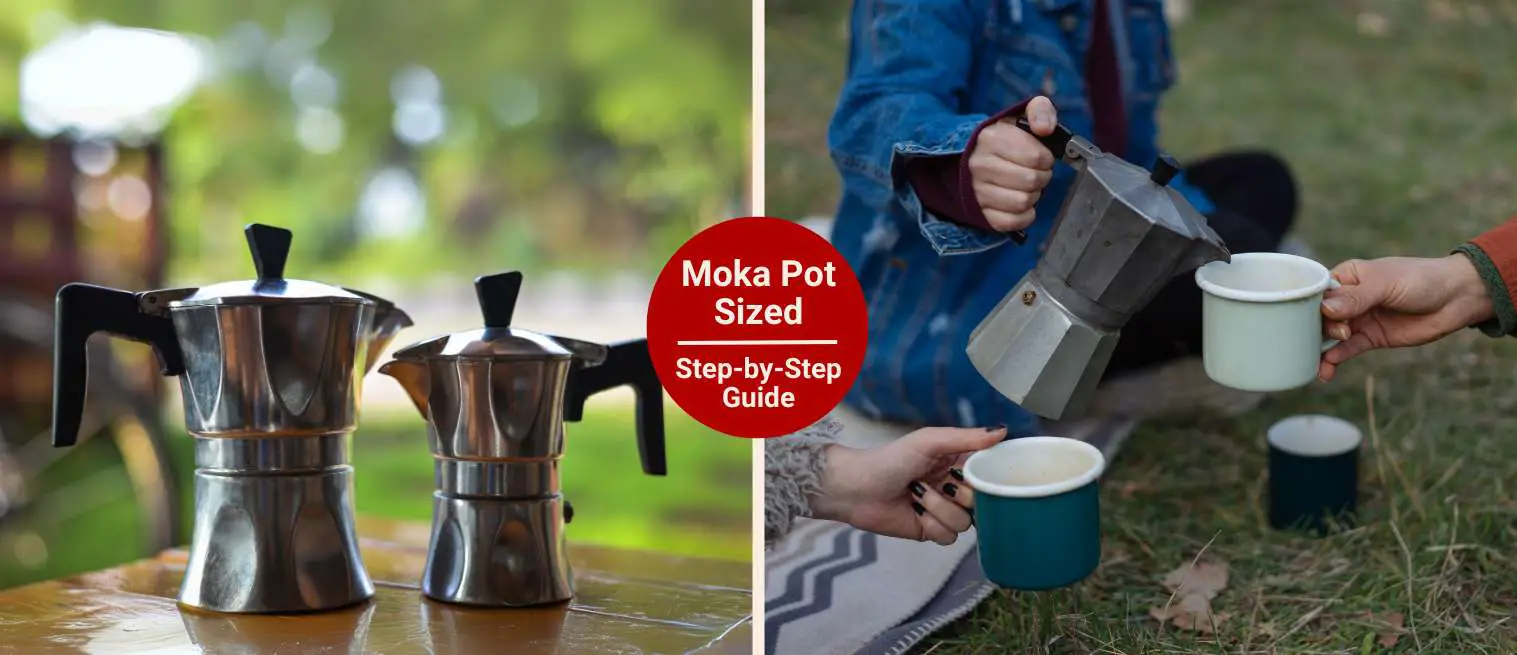Moka Pot Sizes Explained: Find the Right One for You
Last updated on August 30th, 2025 at 03:56 pm
Ever tried shopping for a moka pot and thought, “Wait, what’s a 6-cup? And why does it look smaller than my morning mug?”
I remember my first time picking one out. I assumed a “3-cup” moka pot meant three big cups of coffee. And guess what? It didn’t!
What I ended up with was three tiny espresso shots that barely filled half my travel mug. At first, it felt like I got tricked, but really, it was just me not understanding how moka pot sizes work.
If you’ve been as confused, don’t worry, you’re not alone.
In this guide, you’ll learn what those cup numbers mean, how much coffee each moka pot really makes, and which size is the right fit for your routine. So let’s start brewing!
Key Takeaways
- Moka pot “cups” are espresso servings, not mugs: 1 cup equals about 1.5–2 oz, so a 6-cup moka pot makes closer to 9–12 oz (about two small mugs).
- Each moka pot size has a fixed capacity: you can’t brew fewer cups in a larger pot. For this reason, having multiple sizes might be handy.
- Choose size based on lifestyle: 1–3 cup pots are best for solo drinkers, 4–6 for couples, 9–12 for families, and 18 for entertaining.
- Brand options vary: classics like the Bialetti Moka Express run from 1–18 cups, while designer models like Alessi Pulcina top out at 6 cups.
How Moka Pot Sizes Work?
If you’ve ever unboxed a moka pot and thought, “Wait… this 3-cup thing barely fills my mug!” you’re not alone. The whole trick is understanding what “cups” mean. So let’s talk a closer look:
What Does “Cup” Mean?
When you see a moka pot labeled 1-cup, 3-cup, or 6-cup, those “cups” don’t match American coffee cups.
Instead, they’re based on Italian espresso servings roughly 1.5 to 2 ounces (about 50 ml). For this reason, a 3-cup moka pot will only give you around 6 ounces total. That’s one standard coffee mug or two small espresso shots.
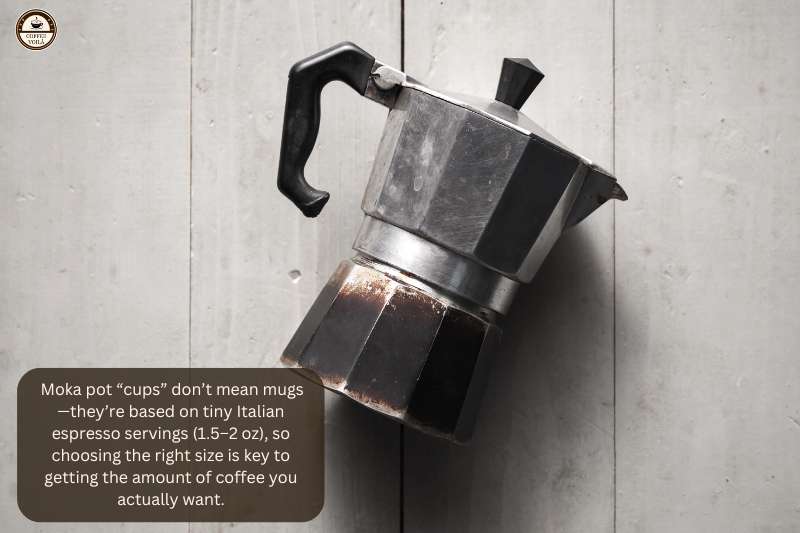
A 6-Cup Example
Take the classic 6-cup moka pot. On the box it sounds like you’re getting enough to fuel a small army, but in reality it brews about 9–12 ounces. It brews enough for two small mugs, or one large travel tumbler.
Why You Can’t Brew Less?
Well, moka pots are designed with a fixed basket and chamber size. You can’t half-fill the basket and expect it to brew properly. The pressure won’t build correctly, and you’ll either burn the coffee or end up with weak, watery results.
Owning More Than One Size
This is why many moka pot fans (me included) end up with more than one size. I keep a 3-cup for solo mornings and a 9-cup for weekends when friends come over.
It’s easier than trying to force one pot to do it all. Think of it like pans in the kitchen. I mean, you wouldn’t fry a single egg in your Thanksgiving turkey roaster, right? Same logic here.
Moka Pot Size Chart (1–18 Cup)
To make this easier, here’s a size chart that shows exactly how much coffee each moka pot really makes. Plus some popular examples so you can match them to your needs.
| Moka Pot Size | Coffee Output (approx) | Serves | Best For | Popular Examples |
|---|---|---|---|---|
| 1-Cup | 1.5–2 oz | 1 shot | Solo espresso drinkers | Bialetti Moka Express 1-Cup, Alessi Pulcina 1-Cup |
| 2-Cup | 3–4 oz | 1 small mug | Quick single servings | Grosche Milano 2-Cup, Ilsa Stainless 2-Cup |
| 3-Cup | 6 oz | 1 mug / 2 shots | Everyday solo use | Bialetti 3-Cup, Cuisinox Roma 3-Cup |
| 4-Cup | 8 oz | 1 large mug | Strong morning coffee | Alessi Pulcina 4-Cup, Grosche Milano 4-Cup |
| 6-Cup | 9–12 oz | 1–2 mugs | Couples / small households | Bialetti 6-Cup (most popular size), Cuisinox Roma 6-Cup |
| 9-Cup | 18 oz | 2–3 mugs | Sharing coffee with friends | Bialetti 9-Cup, Grosche Milano 9-Cup |
| 12-Cup | 25 oz | 3–4 mugs | Family or office use | Alessi 9090 10-Cup (close equivalent), Bialetti 12-Cup |
| 18-Cup | 27–32 oz | 5–6 mugs | Big gatherings or parties | Bialetti 18-Cup, Cuisinox Roma 12–18 Cup range |
How to Choose the Right Moka Pot Size?
Picking the right moka pot size comes down to how much coffee you drink in one sitting and who you’re sharing it with. I’ve learned the hard way that guessing wrong either leaves you brewing multiple rounds or wasting half a pot.
For Solo Drinkers
If it’s only you and your morning espresso ritual, a 1–3 cup moka pot is perfect. I personally love the Bialetti Moka Express 3-Cup.
This makes about 6 ounces, which is enough to fill a single mug or give you two small shots if you want to stretch it. Anything bigger and you’ll probably find yourself pouring out stale coffee later.
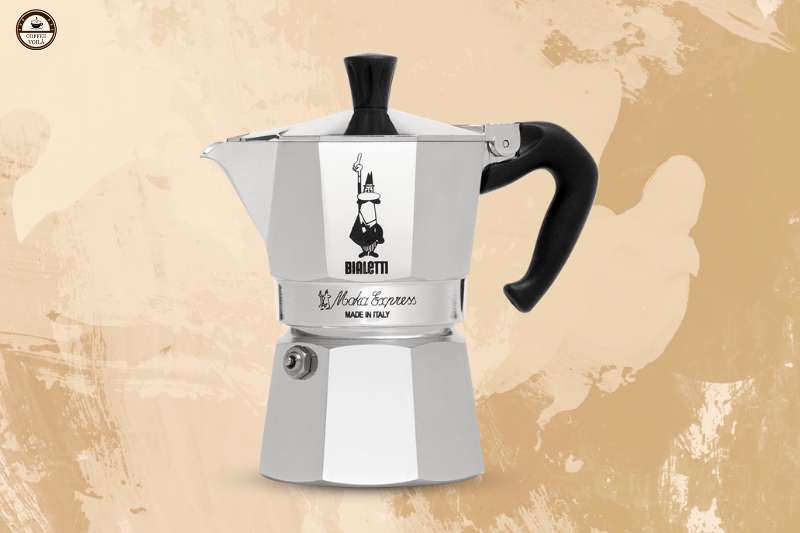
Bonus tip: These smaller moka pots heat up faster and are super portable. This makes them a great pick for camping.
For Couples
When brewing for two, I’d recommend a 4–6 cup moka pot. The Grosche Milano 6-Cup is a sweet spot here. It’s sturdy, affordable, and makes enough coffee for two mugs without the hassle of having to brew twice.
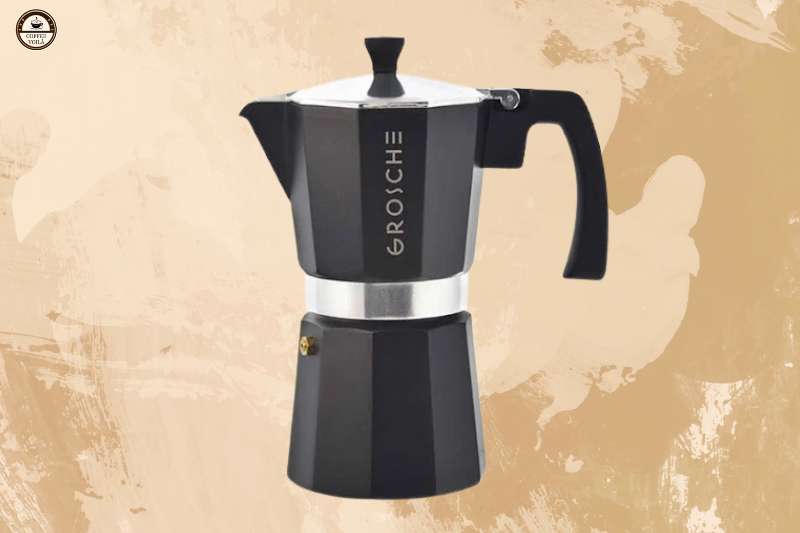
For Families
If you’ve got more than two coffee drinkers at home, or you’re brewing for weekend brunches, step up to a 9–12 cup moka pot.
The Alessi 9090 10-Cup is both practical and quite a showpiece. I mean, it looks sleek on the stove and makes enough coffee for the whole table. It’s especially nice if your family likes to linger over coffee, because you won’t run out after the first pour.
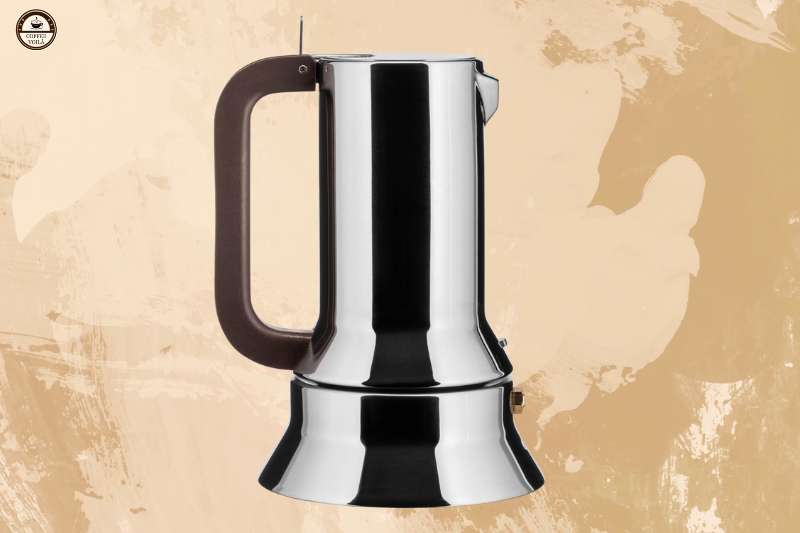
For Entertaining
For big gatherings, or if you’re that friend who always ends up hosting, you can’t go wrong with an 18-cup moka pot. The Bialetti 18-Cup is massive, cranking out up to 32 ounces of strong moka coffee in one go.
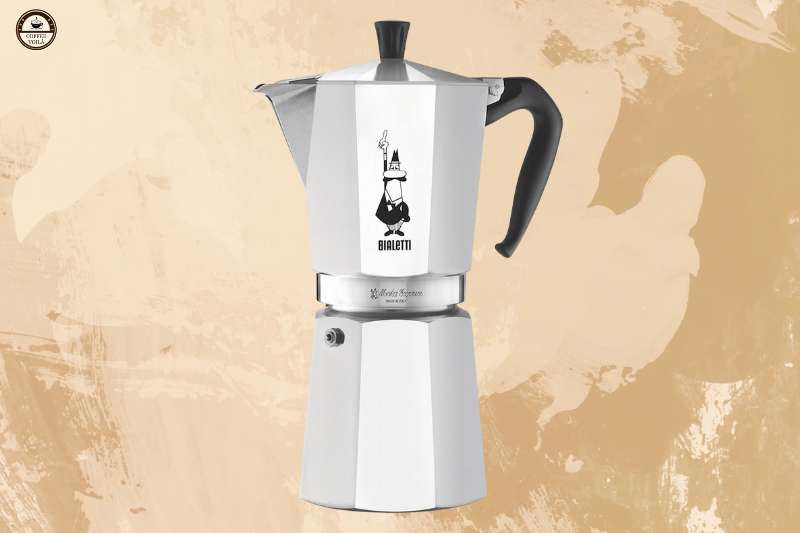
You can use it during family reunions, and it saves you from spending half the morning standing over the stove brewing multiple rounds. Sure, it takes up more space on the burner, but for serving a crowd, it’s unbeatable.
Popular Brands & Their Size Options
If you’ve ever browsed moka pots, you know the brand name matters almost as much as the size. Some focus on tradition, others on design, and a few on durability for everyday brewing. For this reason, here are a few of the popular moka brands and what size options you have:
Bialetti Moka Express (1–18 cups)
The original moka pot, invented back in 1933 by Alfonso Bialetti, and still the most iconic. It’s made in Italy with its classic octagonal shape and the little gentleman with a mustache logo. Their sizes range from tiny 1-cup pots to 18-cup giants for entertaining.
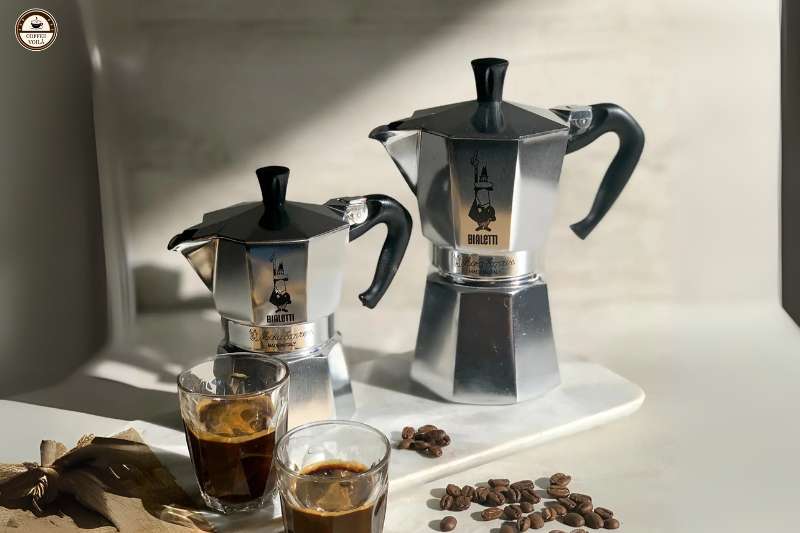
One thing to note: cleaning is simple. You simply rinse with water, no detergents, and don’t toss it in the dishwasher unless you want to ruin the flavor.
Grosche Milano (3–9 cups)
A solid alternative if you want modern tweaks on the classic design. You can choose between aluminum and stainless steel.
Grosche Moka pots come with premium silicone gaskets, a soft-touch handle with a burn guard, and an Italian-made safety valve.
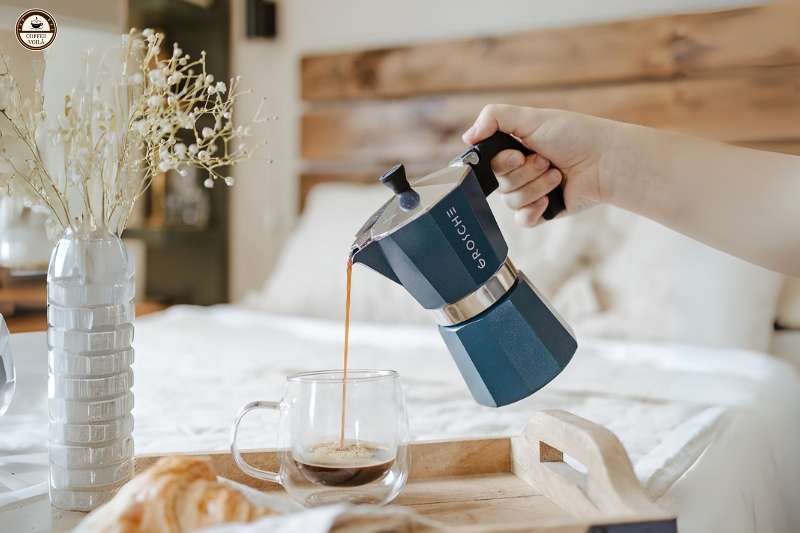
I’ve found the 6-cup version to be a sweet spot for couples. Also, they’ve become popular among home brewers who prefer a slightly safer and more comfortable grip compared to older designs.
Alessi Pulcina (1–6 cups)
If you care as much about style as your coffee, Alessi is where design meets function. Their Pulcina moka pot, designed by architect Michele De Lucchi. These mokas come in sleek aluminum with a beak-like spout to reduce dripping.
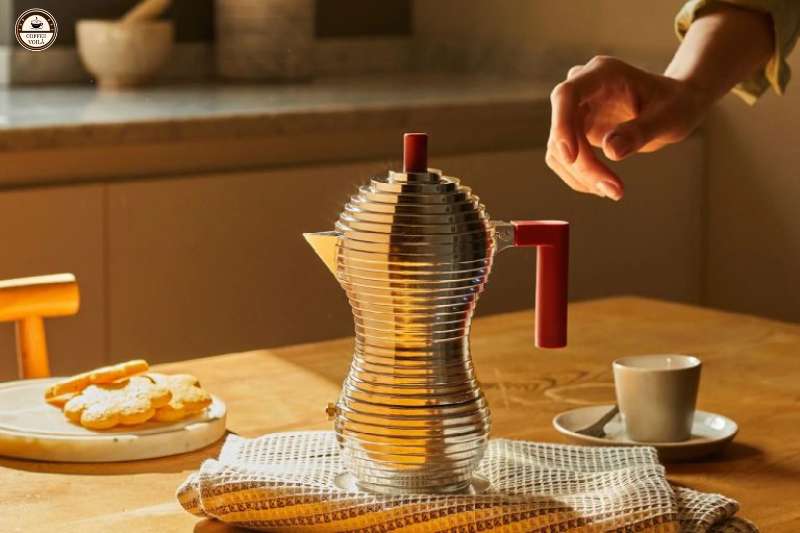
Usually, they’re available in 1, 3, and 6-cup models, perfect for solo drinkers or smaller households. Their other premium model, the Alessi 9090, even comes with a magnetic base for induction stoves (rare in moka pots).
Cuisinox Roma (4–12 cups)
A premium choice if stainless steel is a must. The Roma series feels hefty in the hand and has a polished look that stands out on the counter. Sizes commonly range from 4 cups to 12 cups. This makes them practical for daily use or small families.
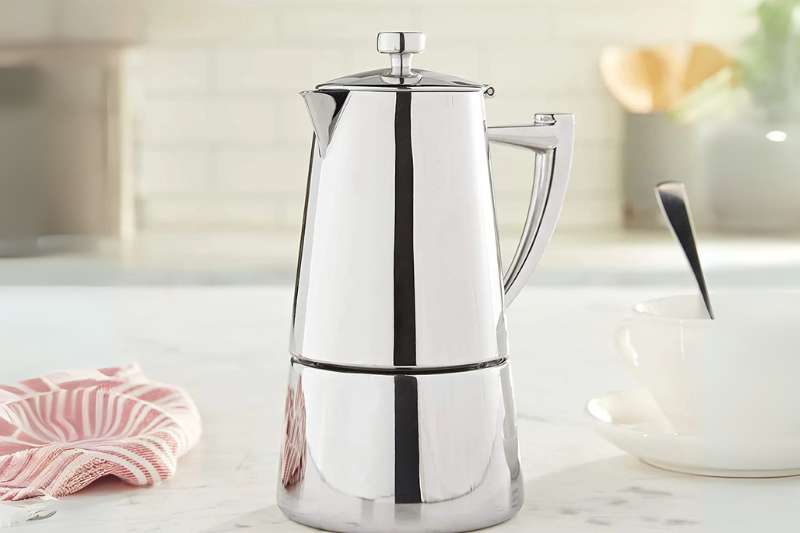
They’re more expensive than aluminum moka pots. However, you get durability, dishwasher safety, and better compatibility with induction burners.
Tips for Picking the Best Size
Choosing the right Moka depends on how you actually drink your coffee on a day-to-day basis. I’ve learned this the hard way after buying sizes that didn’t match my routine.
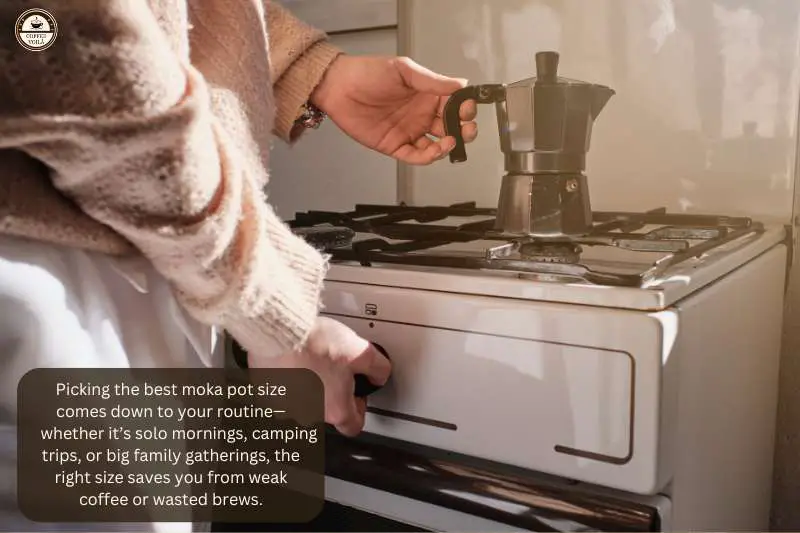
1 – Think about how many people you usually brew for
This one sounds obvious, but it’s easy to overlook. If it’s just you in the mornings, a 1–3 cup moka pot is more than enough.
The first moka pot I bought was a 9-cup because it looked impressive… and I ended up wasting coffee almost every day.
2 – Remember moka pot coffee is concentrated
A moka pot makes strong, espresso-like coffee. If you want a full mug, you’ll probably end up adding hot water (like an Americano) or milk for lattes. I recommend thinking in “shots” instead of mugs. This makes the sizing a lot clearer.
3 – If in doubt, size up
You can always make a big pot and share. However, you can’t underfill a moka pot without messing up the extraction. When I was torn between a 3-cup and a 6-cup, I went with the 6 and I don’t regret it. It’s saved me on mornings when one cup just wasn’t enough.
4 – Consider portability if camping or traveling
A 1–3 cup moka pot is light, compact, and fits in a backpack. For instance, you can carry a 3-cup Bialetti on camping trips, and it feels almost indestructible compared to bigger pots. Anything larger gets awkward to pack.
5 – For entertaining (9–18 cup models)
If you often host family brunches or dinners with friends, a big moka pot is worth it. The reason is brewing round after round in a small one gets old fast. For example, an 18-cup Bialetti makes enough in one go to keep a whole table buzzing.
Last Thoughts
What size moka pot do you use at home? Do you prefer a smaller one for quick solo shots, or do you like the big 9–12 cup versions for family breakfasts?
And have you ever tried brewing with one of those giant 18-cup moka pots?
So, share your experiences and tips in the comments below. I’d love to hear how you make your moka pot work for you. And with that, voilà!
Questions? We Have Answers.
Get answers to a list of the most Frequently Asked Questions.

